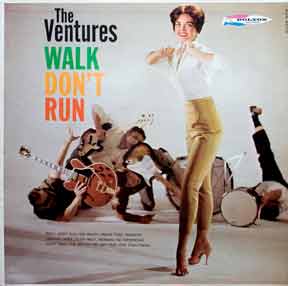Rabbit Farm* Boy Makes Rock & Roll Hall of Fame
by Jerry Bates
For those of us who were teenagers in the early 1960s the Ventures music meant cranking up the radio volume while cruising Puyallup. The Ventures made all the national pop charts of the time, and best of all they were a Tacoma band with a bass player who grew up on South Hill!

1961 Walk Don't Run album cover
The Ventures have finally been recognized by the Rock and Roll Hall of Fame (long overdue). If you were at the Liberty Theater in Puyallup, March 10th 2008 around 7 PM, you could have watched the ceremony awarding the Ventures, along with Madonna and others, their award. The ceremony was carried to the Liberty Theater over a live feed from Cleveland, home of the Rock and Roll Hall of Fame.
South Hill Historical Society member Joan Vosler relates the following story of Nokie Edwards, the bassist for the Ventures when he was a boy living on South Hill:
Nokie (Floyd) Edwards was born on South Hill. He lived on the “Rabbit Farms*.” I didn’t know Nokie although he rode the bus to Puyallup High School.
All of his family were very talented musicians. His sister, Louise, could play anything on the piano you could hum. She couldn’t read music, but who needs to when you have that talent. All of the Edwards family played: fiddle, guitar, bass fiddle, etc. Nokie was the only one that took his talent to a higher level. I do believe all are deceased except Louise and Nokie. I was thrilled when they made it into the Rock and Roll Hall of fame. But the Ventures were very diverse and played country, swing, etc.
We bought their records in Pennsylvania, and it was my husband that noticed Nokie’s name on the album cover. We said, “Holy Cow, that’s little Nokie Edwards!”
* Years ago a place called the Rabbit Farms was well known among Pierce County residents. It was located along 122nd St. E (Main Street in those days). The Rabbit Farms began in the 1930s as a Depression era real estate/livelihood scheme. It was a development consisting of very small cheaply built houses on adjacent lots each with rabbit hutches. The site was designed to be a communal effort to raise rabbits commercially. The idea was to attract residents that would pool together to make incomes raising rabbits during the hard times. Rabbit meat was a growing market back then competing with chicken. For many years after that enterprise failed, people would still refer to the general area as the Rabbit Farms—not South Hill. Maps of that time are so marked.
Our society’s knowledge of the Rabbit Farms is sketchy. Anyone that can add to, or embellish our limited information, please contact us.